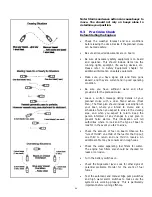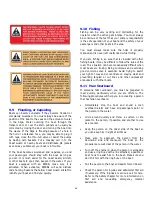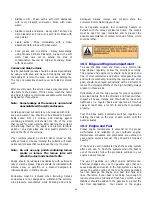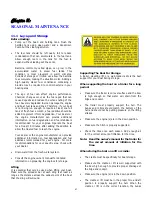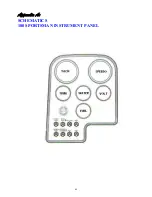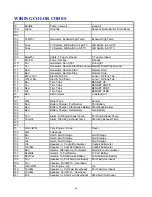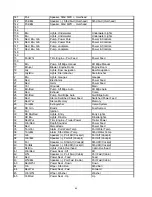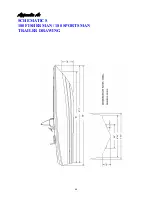
Fiberglass Gelcoat Surfaces
Normal maintenance requires only washing with mild
soap and water. A stiff brush can be used on the
nonskid areas. Kerosene or commercially prepared
products will remove oil and tar which could be a
problem on trailered boats. Harsh abrasive and chemical
cleaners are not recommended because they can
damage or dull the gelcoat, reducing its life and making
it more susceptible to stains. When the boat is used in
saltwater, it should be washed thoroughly with soap and
water after each use.
At least once a season, wash and wax all exposed
fiberglass surfaces. Use a high quality automotive or
boat wax. Follow the procedure recommended by the
wax manufacturer. The washing and waxing of your
boat will have the same beneficial effects as they have
on an automobile finish. The wax will fill minute
scratches and pores thus helping to prevent soiling and
will extend the life of the gelcoat.
After the boat is exposed to the direct sunlight for a
period of time, the color in the gelcoat tends to fade,
dull or chalk. A heavier buffing is required to bring the
gelcoat back to its original luster. For power cleaning
use a light cleaner. To clean the boat by hand, use a
heavier automotive cleaner. Before cleaning the
surfaces, read the instructions given with the cleaner.
After cleaning the surfaces, apply wax and polish all
fiberglass surfaces except the nonskid areas.
If the fiberglass should become damaged and need
repair, contact your dealer for an authorized repair
person to make the repairs.
Stainless Steel Hardware
When using the boat in saltwater, the hardware should
be washed with soap and water after each use. When a
boat is used in a corrosive environment such as
saltwater, water with a high sulfur content, or polluted
water, the stainless steel will periodically develop surface
rust stains. This is perfectly normal under these
conditions. The stainless can normally be cleaned and
protected by using a high quality boat or automotive
wax or a commercial metal cleaner and protectant.
Anodized Aluminum Surfaces
Anodized aluminum should be washed periodically with
soap and water to keep it clean. If the boat is used in
saltwater or polluted water, the aluminum should be
washed with soap and water after each use. Saltwater
allowed to remain on anodized aluminum will penetrate
the anodized coating and attack the aluminum.
T-Tops with anodized aluminum frames, bimini tops with
canvas and/or fiberglass tops require special attention to
the anodized aluminum just below the top. This area is
subject to salt build up from salty condensation and sea
spray. It is also frequently overlooked when the boat is
washed and will not be rinsed by the rain. Consequently,
the aluminum just below the top is more likely to
become pitted than the exposed aluminum on the
structure. Make sure the aluminum in this area is
washed frequently with soap and water and rinsed
thoroughly. Pay particular attention to places where the
top material contacts the frame. Once a month, coat the
entire frame with a metal protector made for anodized
aluminum to protect against pitting and corrosion
caused by the harsh effects of salt water.
Stains can be removed anodized aluminum with a metal
polish or fine polishing compound. To minimize
corrosion, use a caulking compound or teflon based
sealer to bed hardware and fasteners mounted to
aluminum fabrications. If the anodized coating is badly
scratched it can be touched up with paint. With proper
care, anodized aluminum will provide many years of
service.
Powder Coated Aluminum
Powder coated aluminum should be washed periodically
with soap and water to keep it clean. If the boat is used
in saltwater or polluted water, the aluminum should be
washed with soap and water after each use. Saltwater
allowed to remain on powder coated aluminum will
penetrate the coating and attack the aluminum, usually
around fasteners and hardware mounted to the
aluminum.
53
Summary of Contents for 180 Sportsman
Page 2: ...2...
Page 4: ...4...
Page 7: ...180 FISHERMAN SPECIFICATIONS 7...
Page 8: ...180 SPORTSMAN SPECIFICATIONS 8...
Page 9: ...202 FISHERMAN SPECIFICATIONS 9...
Page 10: ...212 FISHERMAN SPECIFICATIONS 10...
Page 18: ...18...
Page 39: ...SAFETY LABELS 2601 1124 39...
Page 40: ...180 FISHERMAN 180 SPORTSMAN CAPACITY LABELS 40...
Page 41: ...202 212 FISHERMAN CAPACITY LABELS 41...
Page 61: ...Appendix A SCHEMATICS 180 FISHERMAN INSTRUMENT PANEL 61...
Page 62: ...Appendix A SCHEMATICS 180 SPORTSMAN INSTRUMENT PANEL 62...
Page 63: ...Appendix A SCHEMATICS 202 212 FISHERMAN INSTRUMENT PANEL 63...
Page 68: ...Appendix A SCHEMATICS 180 FISHERMAN 180 SPORTSMAN TRAILER DRAWING 68...
Page 69: ...Appendix A SCHEMATICS 202 212 FISHERMAN TRAILER DRAWING 69...
Page 70: ...Appendix A SCHEMATICS 180 FISHERMAN OVERHEAD LAYOUT 70...
Page 71: ...Appendix A SCHEMATICS 180 SPORTSMAN OVERHEAD LAYOUT 71...
Page 72: ...Appendix A SCHEMATICS 202 FISHERMAN OVERHEAD LAYOUT 72...
Page 73: ...Appendix A SCHEMATICS 212 FISHERMAN OVERHEAD LAYOUT 73...
Page 77: ...MAINTENANCE LOG 77...
Page 78: ...MAINTENANCE LOG 78...
Page 80: ...Appendix D BOAT ACCIDENT REPORT 80...
Page 81: ...81...
Page 87: ...Appendix F TROUBLESHOOTING GUIDE 87...
Page 88: ...TROUBLESHOOTING GUIDE 88...
Page 89: ...TROUBLESHOOTING GUIDE 89...
Page 90: ...TROUBLESHOOTING GUIDE 90...
Page 91: ...TROUBLESHOOTING GUIDE 91...






